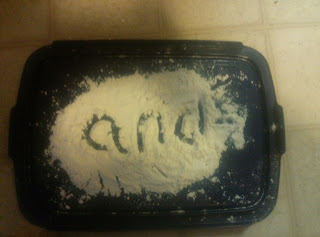Flash card games:
We have several flash card games we like to play. Some of our favorites are Sight Word Go Fish and Sight Word memory. Making sight word flash cards is simple. I just write the sight words we're working on on 3 x 5 cards or even just rectangle pieces of construction paper. I don't spend a lot of time or money on our flash cards since we only use a set for a few weeks before it's time to move onto new words. Make two cards with each word so you can have matches for games like Go Fish and Memory.Sight Word Memory: To play Sight word memory, you just shuffle your deck and lay them upside down in a grid. Then you take turns flipping over two cards each turn. If you get a match, you get to keep them. If you don't get a match, the cards get flipped back upside down. Once all the cards are matched and gone from the grid, the game is over. The player with the most matches wins.
Sight Word Go Fish: Sight Word Go Fish is played just like regular Go Fish, you just use your sight word flash cards instead of a regular card deck.
Sight Word Bang! Another fun one is Sight Word Bang! To play this game, put your flash cards upside down in an empty coffee can or similar container and add 2 or 3 cards that say "Bang!" on them. Mix the cards up and take turns drawing cards. If you can correctly read the card, you get to keep it, if not, it goes back in the can. If you draw a Bang! card, all your cards go back in the can. The game ends after a pre allotted amount of time. Whoever has the most cards wins.
Watercolor resist words:
One of my daughter's very favorite sight word activities is Watercolor Resist Words. For this activity you'll need a white piece of paper, a white crayon, some watercolors and a paint brush. Secretly write a few sight words, or even a whole sight word sentence, on the paper with the white crayon. Then have your child paint the paper with the watercolors (dark colors work best). The words will "magically" appear as the watercolors are applied over them, like a secret message. Have your child read the words to you as she/he finds them.Alternative writing mediums:
A fun way to practice writing sight words is with alternative writing mediums like finger paint or one of our favorites is writing in flour or sand in a pie pan. Kids can use their fingers or an unsharpened pencil.
If you want to get really messy, you can even write in the dirt or mud outside!
Sight word hopscotch:
Sight word hopscotch is great for energetic kids! To play, you just draw a hopscotch court somewhere outside with chalk but instead of numbers, you put a sight word in each box. Then you take turns tossing a stone onto the court and hopscotching. When you come to the square the stone landed on, you have to hop over it shouting the word.
Sight word relays:
This game isn't very fun with a single kid but is lots of fun for two or more kids. You'll need a decent amount of space for this one. Outside on the lawn is best. Write sight words on scraps of paper ( or use your flash cards) and place them in a coffee can or similar container on a chair. Have the kids form a single file line about 100 meters from the chair. The child in front runs to the chair, draws a word, reads it, returns it to the can, and then runs back and tags the next kid in line for their turn. Repeat until every child has had a turn or two.
Yelling for spelling:
This is probably my daughter's all time favorite spelling and sight word activity and it's super simple (but loud). Hold up a sight word flash card. The child shouts the word and then spells it out. For example: if you hold up the card that says "and" the child would shout "and" "a" "n" " d"! Once the child has mastered a set of words, play again without the flash cards so he or she has to spell from memory.
There are so many ways to make recognizing and spelling sight words fun. Get messy, get loud, and have fun with it!
If you enjoyed this post check out:
7 Fun Phonics Activities
Follow me on:
Facebook
Pinterest
Instagram
If you enjoyed this post check out:
7 Fun Phonics Activities
Follow me on:





Terrific ideas for helping kids retain what they've learned.
ReplyDeleteThank you :-)
DeleteGreat ideas! I especially like the yelling one. My son would think that's hilarious! :)
ReplyDeleteThis comment has been removed by the author.
DeleteThanks! Yelling for Spelling is always a favorite around here lol :-)
DeleteThese are great! We do the old school- memorize these words. I definitely think my son would grasp the words better with these activities. I see hopscotch in the near future.
ReplyDeleteThanks for reading. My daughter is a very active hands on type of learner so I've really had to get creative for her. Sight word hopscotch is a favorite around here :-)
Delete